What Is The Percenntage Growth Rate Of Registered Nurse In North Carolina
![]()
We're going to need a lot more nurses.
The need for registered nurses is expected to grow by 9% from 2020 to 2030, equally fast equally average growth beyond all occupations, according to the Bureau of Labor Statistics. Similarly, the need for licensed practical nurses (LPNs) is projected to abound past 9% and nursing assistants by viii% over the aforementioned period. With an aging baby boomer population, climbing rates of chronic issues like obesity and diabetes, and a growing emphasis on preventative care, will the healthcare industry exist able to keep upwardly with the demand for registered nurses?
We analyzed future registered nursing employment every bit estimated past the National Center for Health Workforce Analysis in a 2017 study. We discovered that by 2030, the number of registered nurses needed in the United States is estimated to skyrocket by 28.iv% from two.8 million to 3.six one thousand thousand. While almost states are projected to keep up with demand, in that location are many places that are expected to have meaning shortages in registered nurses.
California is expected to be short the most registered nurses (45,500), while Alaska is projected to take the most chore vacancies (22.7%). Texas, New Jersey, South Carolina, Georgia and S Dakota are expected to experience shortages as well. Florida will have the most extra nurses (53,700), along with Ohio, Virginia and New York. Wyoming will accept the biggest overage in RNs (50.9%), followed by New Mexico and Ohio.
***
How COVID-nineteen Has Impacted the Nursing Shortage
As the COVID-19 pandemic began to sweep across the state in early 2020, nurses who were already stretched thin saw their roles and responsibilities aggrandize even farther. Without the staff to keep upward with the influx of patients, nurses found themselves in the stressful position of providing care every bit hospitals struggled to provide enough equipment and necessary PPE. Nurse-to-patient ratios shot up; in California, where there are laws governing how many patients a nurse may treat at once, special increased pandemic ratios were authorized to handle the surge. Many nurses have reported feelings of chore-related burnout, anxiety, depression, and fear due to the workload and risks of this pandemic.
Not only this, but nurses and other healthcare providers who tested positive for COVID-xix themselves were and then asked to quarantine, placing additional strain on already nether-staffed units. On top of this, according to an October 2020 study from the Centers for Disease Control and Prevention (CDC), nursing-related occupations had the highest incidence of COVID-19 hospitalizations (36%) amidst healthcare personnel.
While non all the data is in yet regarding how the pandemic has fully impacted the nursing shortage, it's clear that the repercussions of this event may accept lasting long-term effects for patients and healthcare organizations alike.
***
The staff here at RegisteredNursing.org looked at the projected supply and demand of registered nurses in 2030 to make up one's mind which states would have the largest shortages.
Projected RN Shortages by State
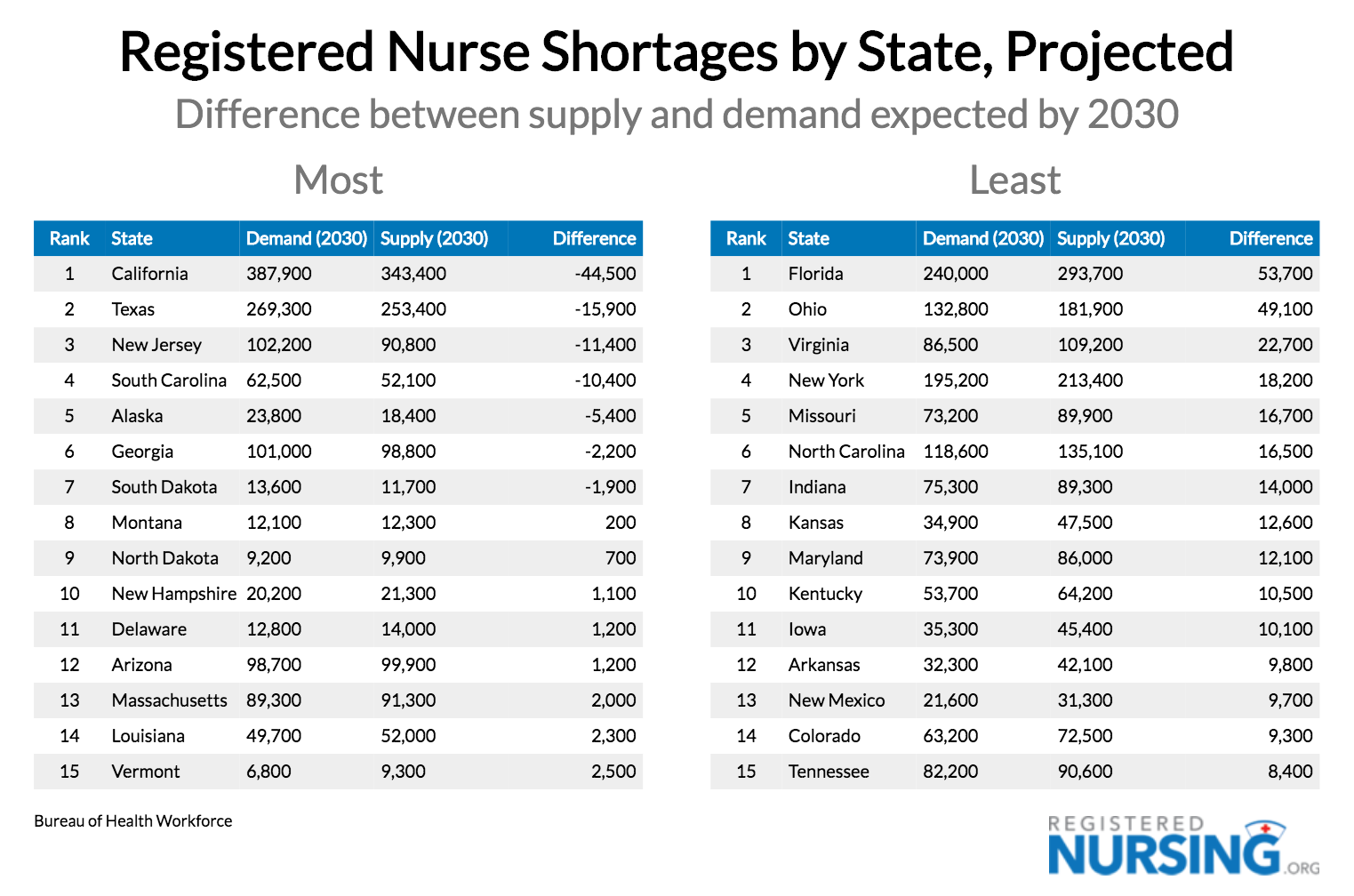
California tops the list with an estimated 44,500 deficit in registered nurses, virtually iii times the arrears in the next shortest state. Texas, New Jersey and S Carolina will lack more than ten,000 RNs; Alaska, Georgia and South Dakota will each be short several k.
On the flip side, Florida will have far too many RNs, with a projected overage of 53,700 nurses. Ohio comes close with 49,100 more registered nurses than it will need. Virginia, New York, Missouri and North Carolina are estimated to have more than 15,000 extra RNs.
California and Florida are huge states with already high numbers of registered nurse positions. How does the shortage look when we take the size of the workforce into account? We ranked states based on the percentage of the registered nurse workforce that is projected to be vacant or overfilled.
Projected RN Employment
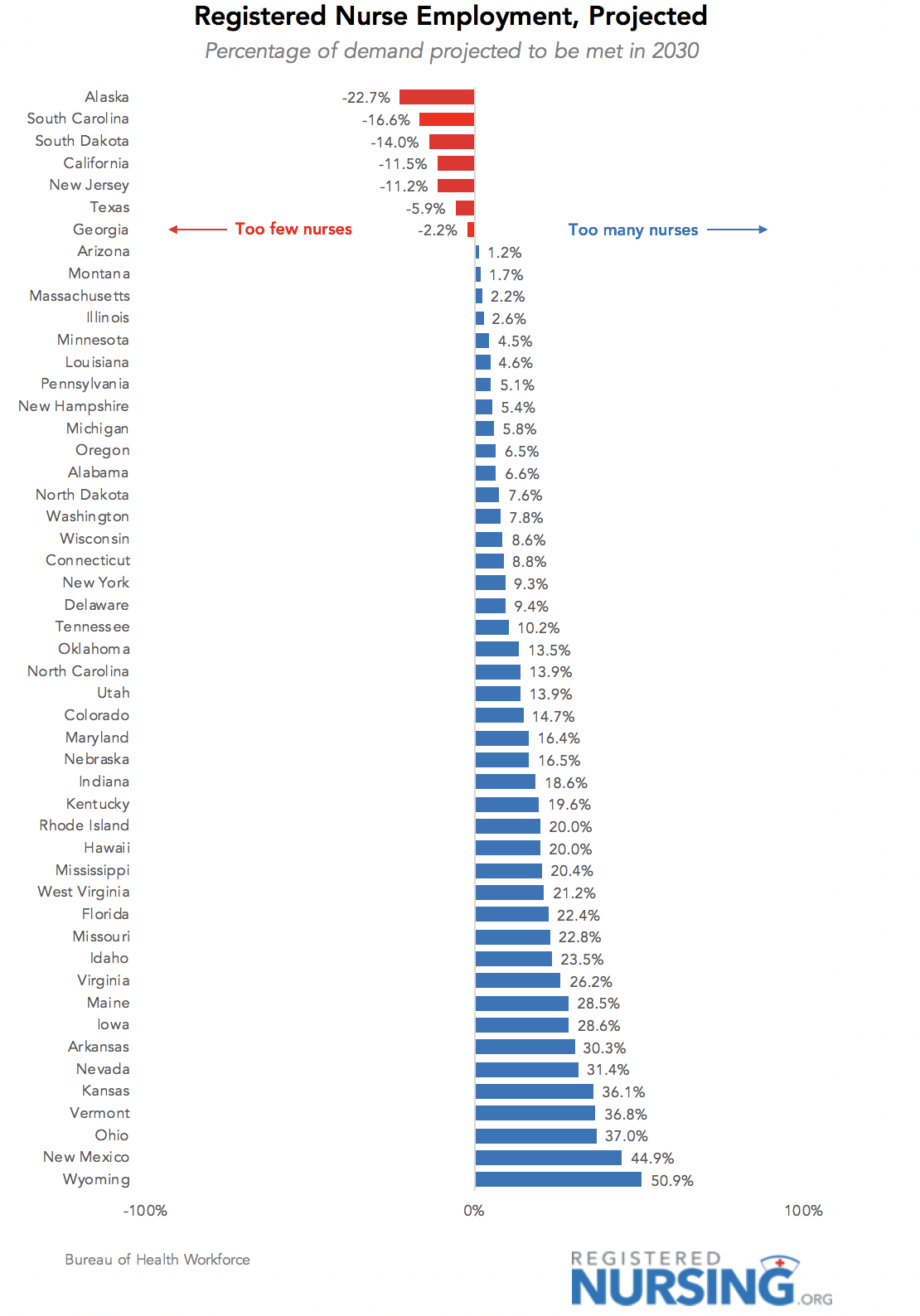
Alaska, projected to exist short five,400 RNs, will have the largest per centum of the workforce missing – more than 22% of the needed 23,800 registered nurse positions volition be unfilled. South Carolina and South Dakota will each exist missing about fifteen%, followed by California and New Bailiwick of jersey, defective about xi% of needed RNs.
The largest overage will be in Wyoming, where there are projected to be eight,300 nurses filling 5,500 positions. New United mexican states will take 45% too many nurses, with 31,300 registered nurses to comprehend merely 21,600 needed jobs. Ohio, Vermont, Kansas and Nevada are all estimated to have more than 30% too many registered nurses.
Overall, the state is expected to add 795,700 new registered nursing positions past 2030. Are the new positions going to be added in united states of america that need them most? Nosotros looked at which states had the highest number of projected new registered nurse jobs.
Projected States with Most New RN Positions
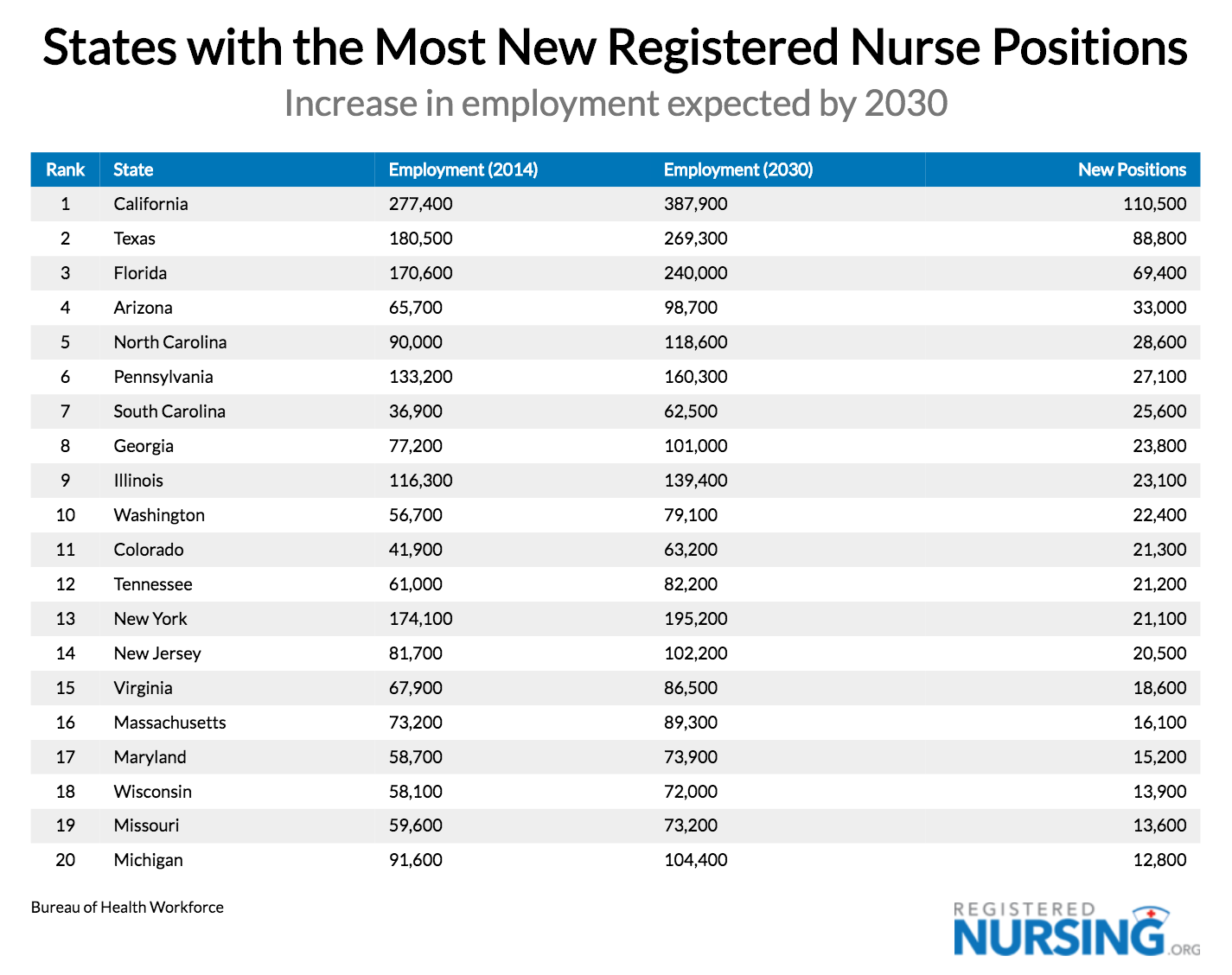
California is expected to add 110,500 new registered nurse positions by 2030, followed by Texas, adding 88,800. Neither corporeality is expected to exist enough to counter the shortage both states will face.
Florida, on the other hand, is expected to add together besides many positions, creating 69,400 new registered nurse jobs, resulting in an overage of more than 50,000 nurses.
How do the number of new positions compare to the existing registered nurse puddle in each land? Nosotros looked at u.s.a. with the biggest and smallest percentage growth in jobs for registered nurses past 2030.
Projected States with Well-nigh & To the lowest degree Growth in RN Positions
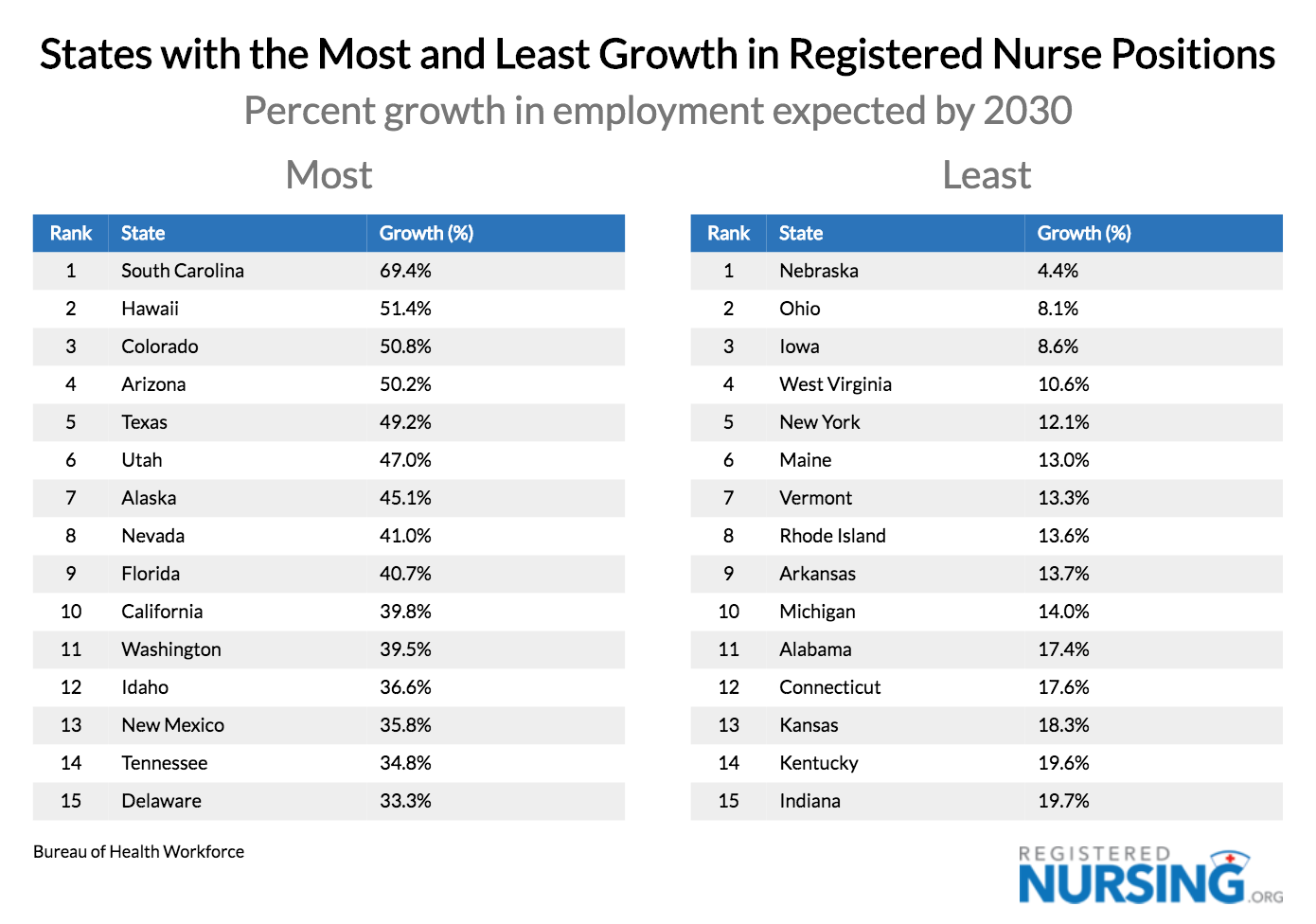
South Carolina is expected to experience the most growth, adding 26,600 new jobs to an existing workforce of 36,900 registered nurses (69.4%). Hawaii follows with 51.4%, or 5,600 new positions added to the 10,600 already working on the islands.
Nebraska is expected to grow the least past 2030, calculation simply 900 new registered nurse jobs to the existing 20,300 (4.four% growth). Ohio and New York are amidst those with tedious growth rates (8.i% and 12.1%, respectively) that are expected to have large overages every bit the supply of registered nurses outpaces demand.
Growth is extremely uneven beyond states and regions, resulting in expected shortages and overages of registered nurses. Are the places that are going to be brusk-handed doing all they can to attract new RNs to their states? To notice out, we consulted the Bureau of Labor Statistics to determine which states take the highest and lowest wages for registered nurses.
States with the Highest & Lowest Pay for RNs
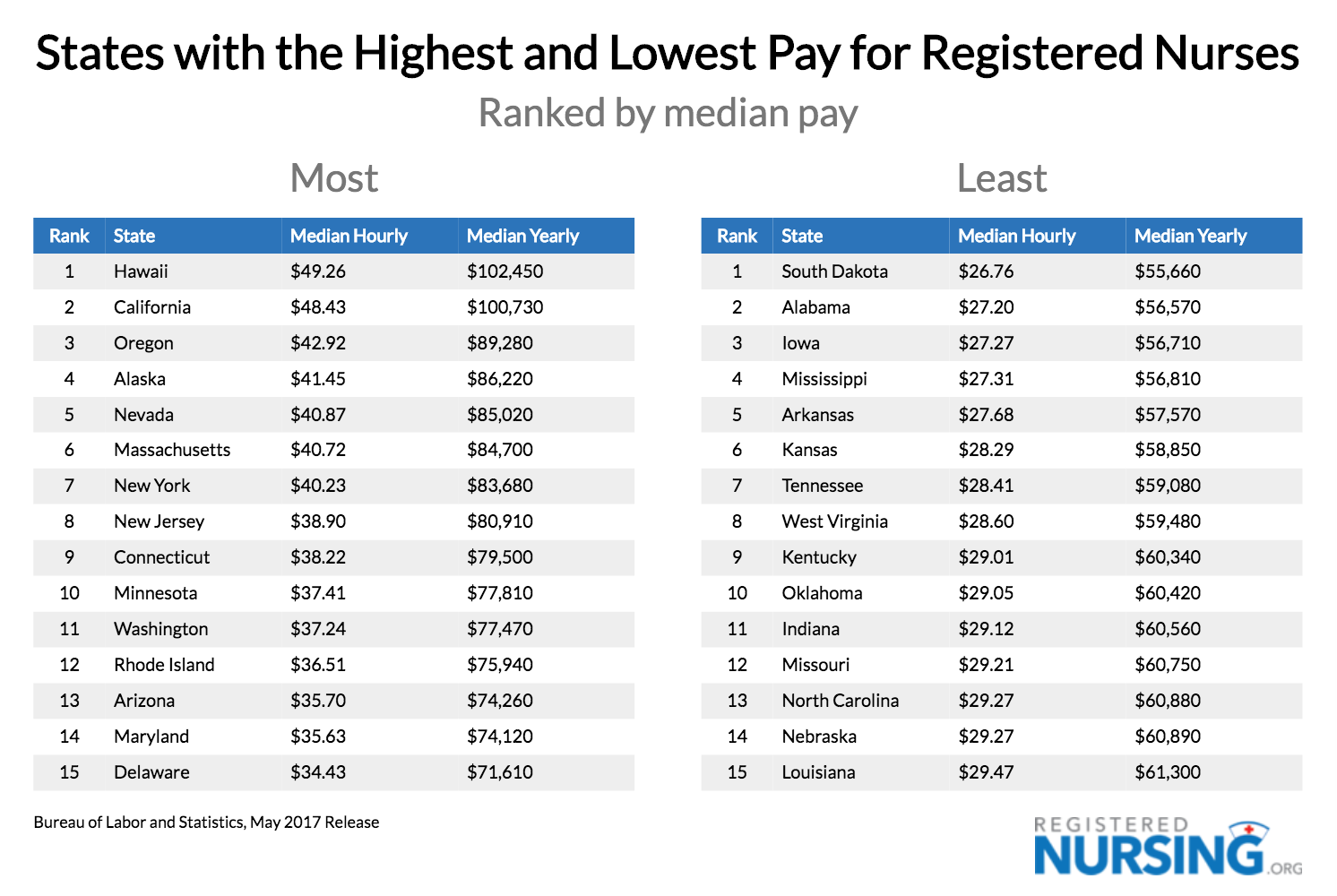
Hawaii and California pay RNs more than whatsoever other states, with median wages totaling more than $100,000. College cost of living and growth contribute to high wages in western states, with Oregon, Alaska, and Nevada following with wages betwixt $85,000-$90,000. Southern and Midwestern states tend to pay less, partly as a function of price of living. Despite facing an oncoming RN shortage, Due south Dakota offers the everyman annual median pay at $55,660, alongside Alabama, Iowa and Mississippi.
To see if projected shortages are influencing wages, we looked at the values using a scatter plot.
Projected RN Shortages / Overages vs Pay
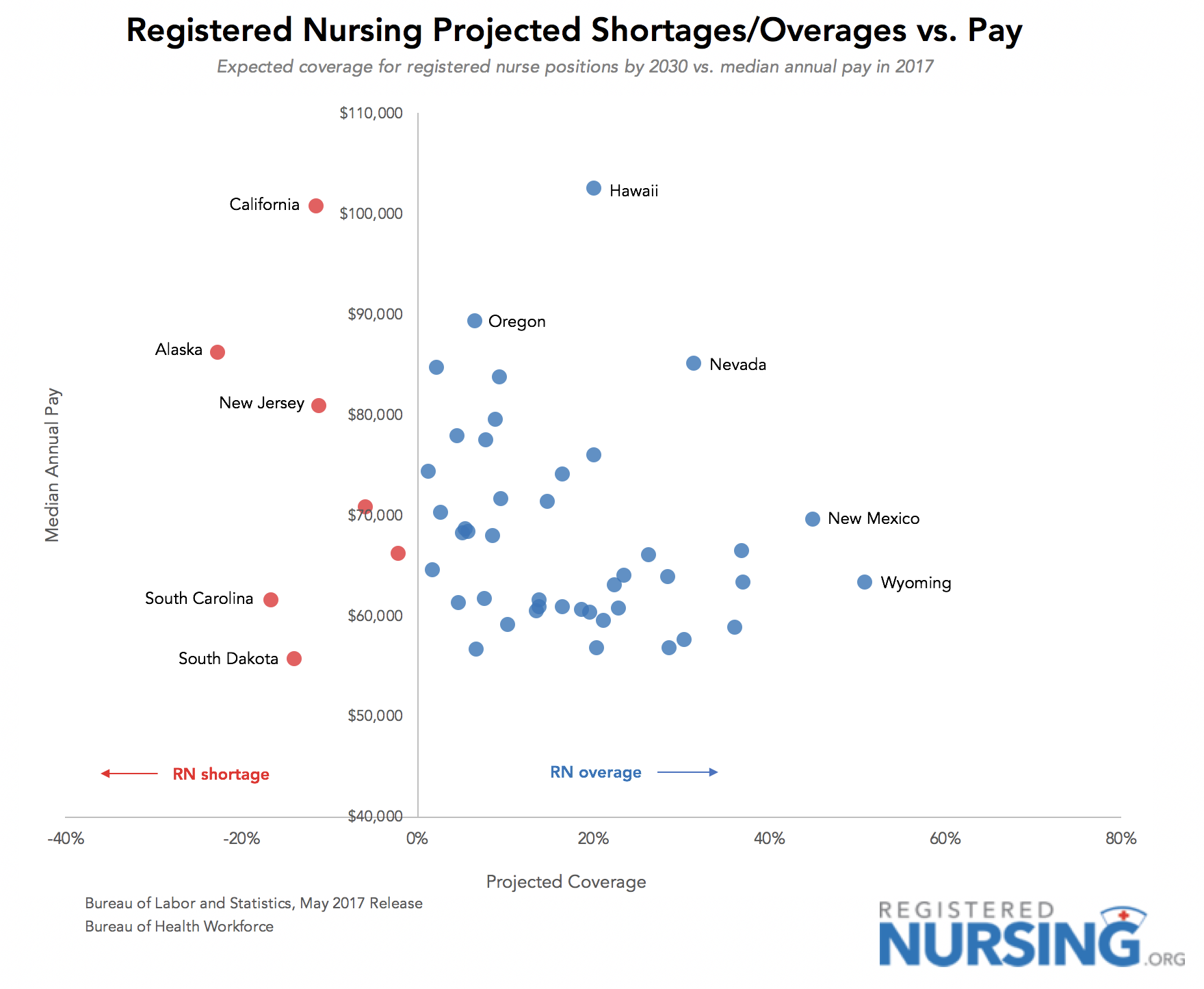
RN salaries remain a function of price of living and location, with annual median wages being barely afflicted by impending registered nurse shortages. States with expected shortages take pay rates ranging from more than $100,000 in California to under $60,000 in South Dakota. States facing overages are similarly all over the map, from $102,000 in Hawaii to $56,000 in Alabama.
With most states facing an overage of registered nurses, it will be increasingly important for RNs to distinguish themselves from their peers and job competitors. Registered nurses with four-year Bachelor of Nursing (BSN) degrees are more than likely to hold supervisor positions and earn higher salaries. Practicing RNs with Associate degrees or diplomas are seeing the benefit, likewise, with the pct of BSN graduates who pursued an RN to BSN plan soaringrand from 29.4% in 2009 to 47.two% in 2017.
RN to BSN Graduates
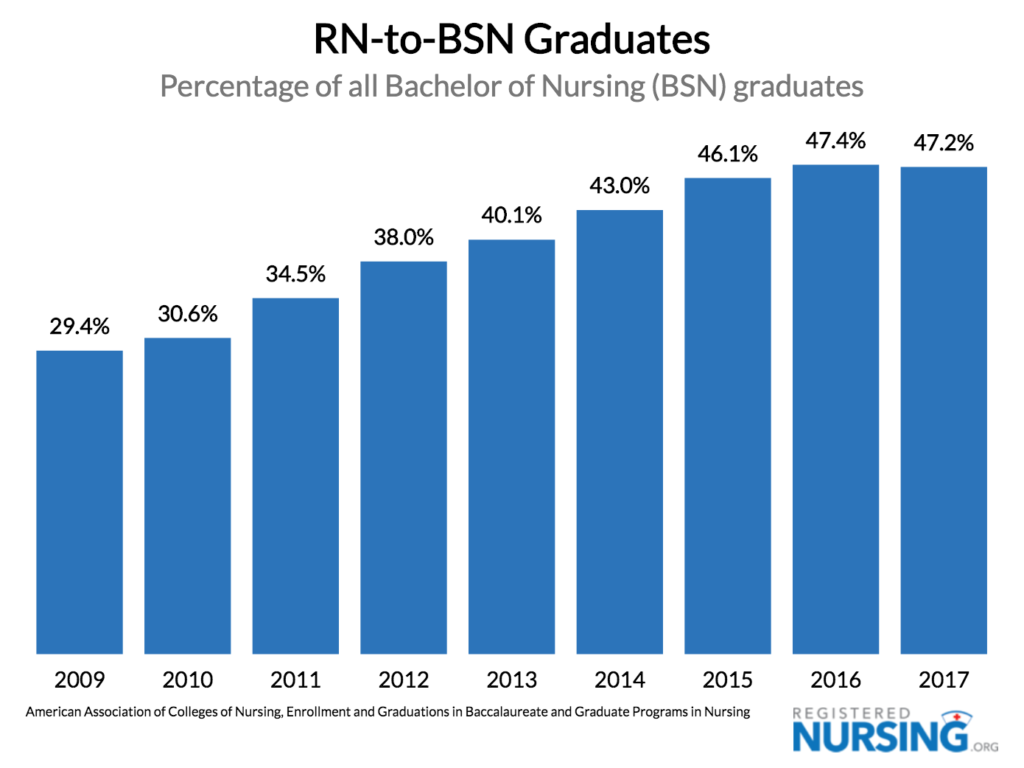
***
The need for registered nurses is growing twice as fast as the boilerplate occupation. By 2030, the demand for RNs is estimated to grow by 795,000 full time positions, from 2.8 to 3.6 meg jobs. Non all states are prepared to handle the rapid increment in demand.
California will exist adding the about new positions past 2030 – more than than 110,000 – but is however estimated to exist more than forty,000 nurses short. Likewise, Texas, New Jersey, South Carolina, Alaska, Georgia and Due south Dakota are all projected to experience shortages in registered nurses. Florida, Ohio and Virginia are estimated to accept the biggest excess in nurses.
RELATED NURSING SHORTAGE CONTENT:
- Is Nursing Education Contributing to the Nursing Shortage?
- Are Changes to the Immigration Laws Affecting the Nursing Shortage?
- Why New Nurses are Leaving the Profession
***
Off-white Use Statement:Please share our content for editorial or word purposes. All we ask is that yous link back to this page and give proper credit to RegisteredNursing.org.
What Is The Percenntage Growth Rate Of Registered Nurse In North Carolina,
Source: https://www.registerednursing.org/articles/largest-nursing-shortages/
Posted by: schoenrockbety1981.blogspot.com


0 Response to "What Is The Percenntage Growth Rate Of Registered Nurse In North Carolina"
Post a Comment